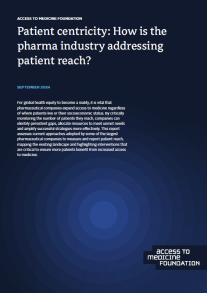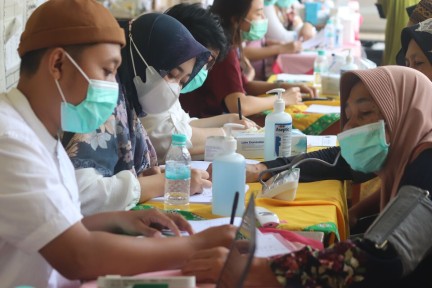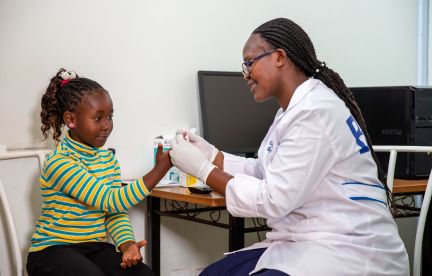Foundation's new report reveals what pharma companies can do to ensure their products reach underserved populations
The report assesses the patient reach approaches of the 20 pharmaceutical companies that will be assessed in the upcoming 2024 Access to Medicine Index.
Encouragingly, 19 of the 20 companies report patient reach approaches. However, the product and country coverage of these approaches varies significantly and only a handful of approaches are comprehensive.
To help guide companies, the report sets out clear, practical recommendations that companies can consider as they continue to develop and advance their patient reach approaches.

Billions of people living in low-and middle-income countries (LMICs) around the world still cannot depend on steady access to lifesaving medications for treatable health conditions. As populations in LMICs continue to grow and demand for essential medicines rises, the need to achieve sustainable access in underserved regions is more urgent than ever.
Over the more than 15 years that the Foundation has been tracking the activities of pharmaceutical companies, stakeholders have begun to respond to the call to prioritise healthcare equity, evidenced by their adoption of more responsible business practices and commitments. However, as access gaps for essential medicines in LMICs persist, it has become clear that a more thorough analysis of patient reach is essential.
Monitoring the number of patients reached by products is essential for pinpointing where access gaps exist. Especially since the number of patients reached in some countries and for some diseases remains unknown, it is vital to work towards accurately mapping the current landscape to ensure companies can more effectively allocate their resources as they expand their access efforts. By doing this, companies and their partners can take steps to bridge access gaps and meet the needs of people across LMICs.
“We have seen that the pharmaceutical industry is making ambitious commitments to reach more patients worldwide. However, this report reveals that there is still much work to be done in achieving meaningful impact and calls for urgent steps to ensure lifesaving products reach every patient, everywhere.”
What is in this report?
Trends and developments in the measurement of patient reach
20 pharma companies’ current patient reach approaches
5 keys insights on companies’ current strategies
7 recommendations for the pharma industry
How companies can use the report to expand efforts
“Health inequity is a chronic problem, most felt by people living in countries facing the highest disease burden. The Access to Medicine Foundation's research insights encourage the pharmaceutical industry to expand their efforts to reach underserved populations globally. We at Wellcome share this vision.”
Five key findings
There has been a notable, yet gradual shift in prioritising the measurement and tracking of patient reach numbers. According to the report’s findings, most companies (19 out of 20) have some approach for tracking the patients they reach with their essential medicines in LMICs.
While the quantity of strategies is positive, findings indicate that companies can work to improve the quality of methods. For instance, about half of the approaches reported measure patient reach by using a basic formula dividing product sales and/or donations volume data by dosing estimates and treatment duration assumptions. While this is a good way to estimate the potential number of patients reached, it is not a true count.
Relatedly, there is no industry consensus on how to calculate patient reach. This results in a wide variety of approaches across companies, making it difficult to compare success of strategies between companies.
Encouragingly, patient reach numbers are now being regularly published. Most companies with a patient reach approach publicly disclose numbers on a regular basis. Among them, nearly all also demonstrate year-on-year improvements in those numbers. However, many companies have only newly begun to engage in public reporting and continued commitment will be essential.
Many commitments by the industry, but only a few companies set ambitious goals to address high-burden diseases. Ideally, goals associated with patient reach should be in line with diseases with high prevalence by region, but the report finds this is not always the case. Goals should be clear, measurable and ambitious and take disease burden into account.
“Companies must prioritise patient reach or risk falling short in addressing health inequity. Our findings lay out a clear path for pharma companies to do this, emphasising how they can embed equitable access within their business operations.”
What’s next?
For global healthcare equity to become a reality, pharmaceutical companies must centre their strategies around the lives of patients most in need. By monitoring patient reach, companies can gather information about which strategies are most impactful, where gaps in access to medicine persist, and how to employ these learnings to improve strategies further.
Additionally, the report underlines a clear need to establish a shared baseline for measuring patient reach to promote consistency. With this, transparency and cooperation between companies will serve to accelerate progress. Detailed recommendations on how companies can continue to refine their patient reach approaches can be found in the report.
The 2024 Access to Medicine Index, slated for release in November, will further evaluate product-specific examples of patient reach and score the 20 companies as part of the overall Index analysis.



